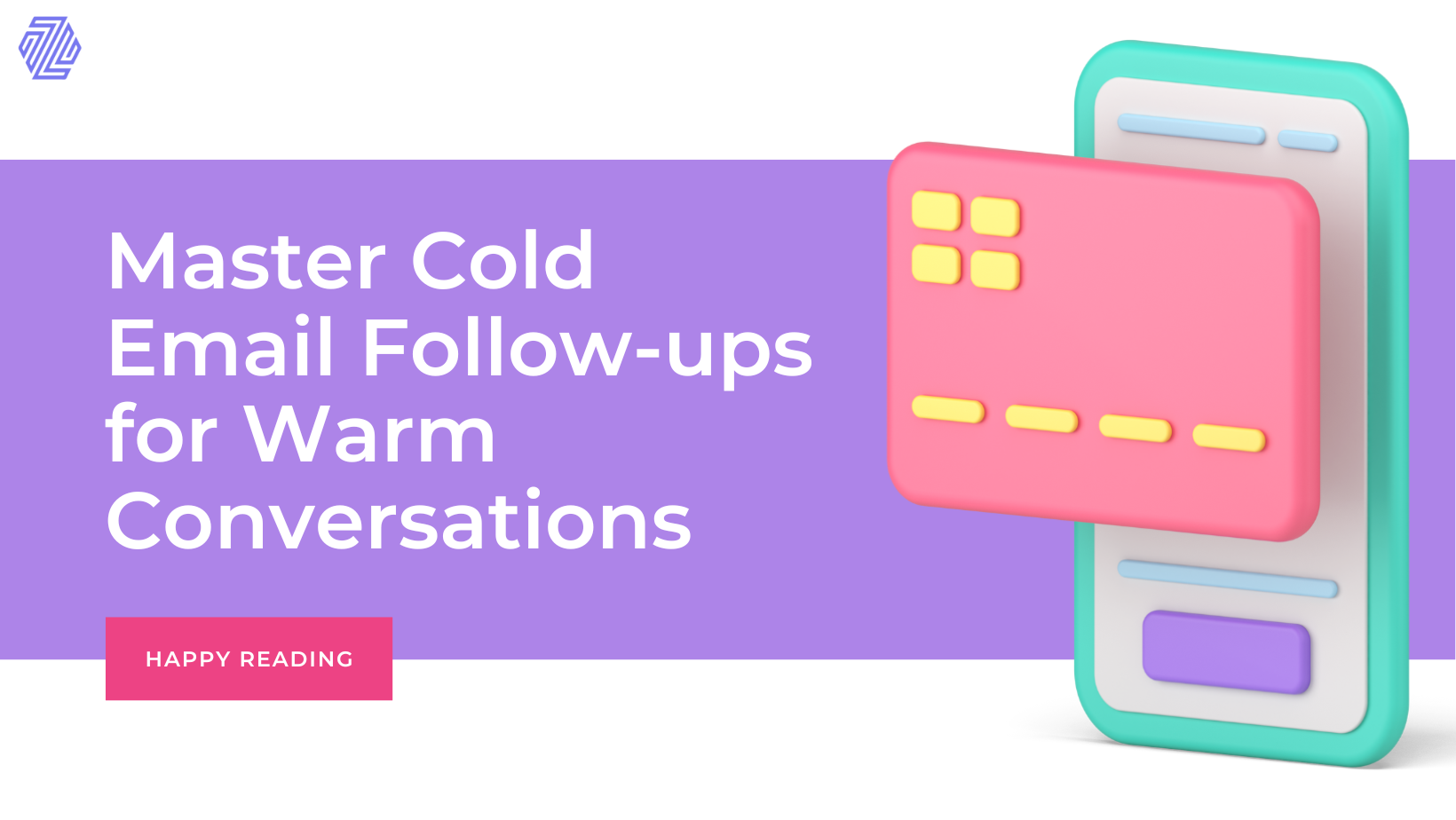Ever had that feeling when you send out a cold email, and it feels like it’s disappeared into the abyss of cyberspace? We’ve all been there. But what if we told you there’s a secret weapon in the email game – the follow-up?
Welcome to the world of follow-up emails, where a well-timed message can turn a cold lead into a warm conversation. It’s like sending a friendly wave to that stranger across the room, only this time, it’s in your inbox.
Think of it as the art of the follow-up, a symphony of strategy, timing, and just the right touch. It’s the ‘ping’ that says, ‘Hey, I’m here, and I’m interested, are you?’
So, let’s dive in and uncover the hidden gems that can transform your cold emails into warm welcomes.
Section 1: Crafting the Perfect Cold Email
1.1 Understanding Your Audience:
- Researching Your Prospects:
Before sending a cold email, it’s crucial to gather information about your prospects. This includes their industry, role, pain points, and any recent news or events related to their business. Example: “I noticed from your recent LinkedIn post that your company is expanding into international markets, which is why I thought our global shipping solutions could be of interest to you.”
Note: Read this article to get tips for Mastering Trust in Cold Emails
- Creating Detailed Buyer Personas:
Develop buyer personas to tailor your messaging to specific customer segments. Understand their challenges, goals, and preferences.
Example:
“For marketing managers like yourself, we’ve found that our automated social media scheduling tool can save up to 15 hours per week. Here’s how…”
1.2. Compelling Subject Lines:
The Hook: Subject Line Best Practices:
Use curiosity, urgency, or a benefit-driven approach in your subject lines to grab the recipient’s attention.
Example:
“Unlocking 30% Cost Savings - Your Exclusive Invitation Inside”
Note: Read this article for more details on how to cold email correctly.
1.3. Captivating Email Content:
- Crafting a Personalized Opening:
Begin your email with something personal to establish a connection and show you’ve done your homework.
Example:
“I read your recent blog post on AI in healthcare, and it got me thinking about how our AI-driven medical diagnostics software aligns with your interests.”
- Communicating Value Proposition:
Clearly state the benefits your product or service offers. Focus on solving the recipient’s pain points.
Example:
“Our project management software streamlines workflows and boosts productivity by 25%.”
- The Art of Call-to-Action (CTA):
Include a clear and concise CTA that guides the recipient on the next steps.
Example:
“Would you be available for a quick call this week to discuss how our solution can address your team’s collaboration challenges. Attaching a schedule link in this email.”
- Using Testimonials and Social Proof:
Include quotes from satisfied customers or statistics that highlight your product’s effectiveness.
Example:
“Over 1,000 businesses, including [Name-Drop Competitor], trust our cybersecurity solutions to safeguard their data.”
Section 2: The Initial Cold Email Send
2.1. Perfect Timing:
- Choosing the Right Day and Time:
Research shows that certain days and times are more effective for cold email outreach.
Refer to this wel documented article by Hyperise to find out more.
Example:
“Based on industry data, Tuesdays and Thursdays between 10 AM and 11 AM tend to have higher email open rates.”
- Time Zone Considerations:
Be mindful of the recipient’s time zone to avoid sending emails at inconvenient hours.
Example:
You noticed that you’re prospect is in San Francisco, so you scheduled this email to arrive in their inbox at 9 AM Pacific time.
2.2. Sending Tools and Software:
- Email Automation Platforms:
Use email automation tools like MailChimp, HubSpot, or Salesforce for managing and tracking cold email campaigns.
- Email Warm-Up Softwares:
Always use email warm-up tools like Instantly, TrulyInbox, Warmup Inbox, and Lemwarm by Lemlist. They ensure the emails land in the customer’s inbox and not in spam.
Note: Read this article for more tips on how to avoid landing in the spam.
- Personalized vs. Mass Emails:
Understand when it’s appropriate to send personalized, one-to-one emails versus mass emails.
Tip:
For high-value prospects, personalized emails are more effective. But for broader outreach, you can use mail merge for efficiency.
Section 3: The Follow-up Strategy
3.1. The Follow-up Sequence:
Follow-up emails are a critical part of your cold email outreach strategy. They allow you to nurture leads, remind recipients of your initial message, and increase the chances of getting a response. Here’s a comprehensive breakdown of the follow-up sequence:
- Timing and Frequency:
Timing is crucial when planning your follow-up sequence. Aim to send your first follow-up email 2-3 days after the initial cold email. Follow-up frequency can vary, but a common sequence includes three to four follow-up emails spaced 3-5 days apart.
Example:
Follow-up 1 (2-3 days after initial email):
“I wanted to ensure you received my previous message and inquire if you had any questions.”
Follow-up 2 (7-10 days after initial email):
“Since I haven’t heard back, I thought I’d share a case study that demonstrates how we helped [similar company] achieve [specific result].”
Follow-up 3 (12-15 days after initial email):
“In case my previous emails got buried, I wanted to reiterate the benefits of our solution, especially [key benefit].”
- The “3-Email Rule”:
Many experts recommend the “3-email rule,” which involves sending three follow-up emails. After the third email, if you still haven’t received a response, it might be time to consider a “break-up” email.
Example:
Follow-up 1: “Gentle Reminder”
Follow-up 2: “Value Reminder”
Follow-up 3: “Last Attempt”
3.2. Crafting Follow-up Emails:
- Follow-up Email Structure:
A well-structured follow-up email is essential for effective communication. Here’s a detailed breakdown of the components to include:
Subject Line: Maintain consistency with your initial email’s subject line or add a reference to your previous message. This ensures recognition in the recipient’s inbox.
Example:
“Follow-up: [Your Previous Subject Line]”
Opening Line: Start with a courteous and personalized opening. Acknowledge your previous contact and restate your purpose briefly.
Example:
“I hope you’ve been well since we last connected. I wanted to circle back regarding [mention the subject of your initial email]”
Reminder of Value Proposition: Reinforce the key benefits of your product or service. Remind the recipient why they should be interested.
Example:
“As a quick reminder, our software has helped companies like [Reference a Successful Customer] increase their efficiency by [specific percentage].”
Additional Value: Offer something extra in this follow-up. Share a relevant resource, case study, or industry insight that demonstrates your expertise.
Example:
“I thought you might find this industry report on [relevant industry topic] interesting. It provides valuable insights into [relevant industry challenge].”
Call-to-Action (CTA): Clearly state the desired action you’d like the recipient to take. This can be a request for a call, a meeting, or simply a response.
Example:
“If you would you be open to a brief call next week to explore how [your solution] can benefit [prospect’s company] specifically, please schedule a link using [CTA]”
Polite Closing: Conclude your email with a courteous closing and express your gratitude for their time and consideration.
Example:
“Thank you for considering our solution, [Prospect’s Name]. I look forward to the opportunity to connect and discuss this further.”
- Leveraging the “Broken Record” Technique:
The “Broken Record” technique involves subtly reiterating your key message and value proposition throughout your follow-up emails. Here’s how to effectively employ this strategy:
- Reiterate the Main Benefit: In each follow-up, emphasize the primary benefit your product or service offers. Keep it concise and to the point.

- Customize Around Pain Points: Tailor your message to address specific pain points or challenges your prospect might be facing. Show them how your solution can provide relief.
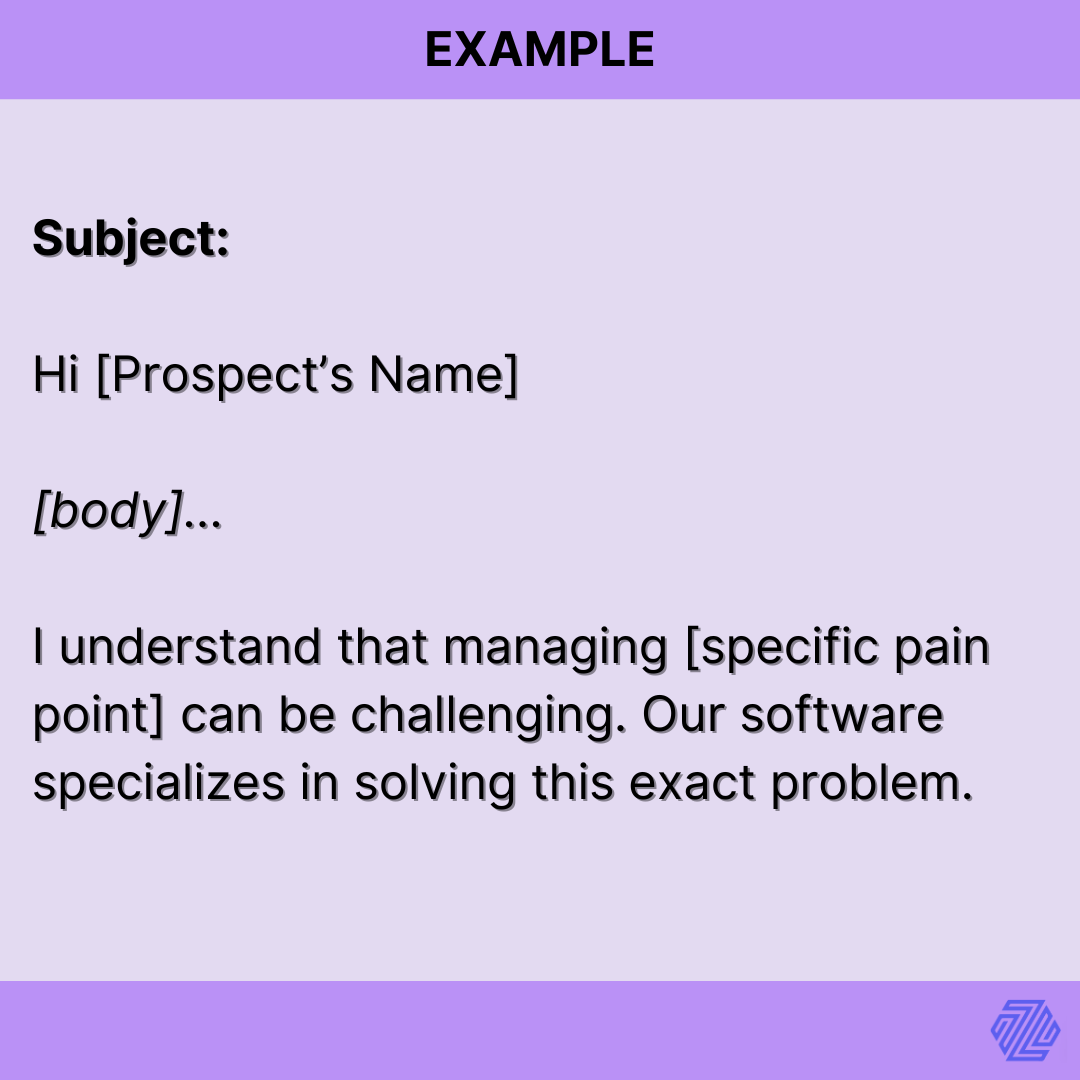
- Use Consistent Language: Keep the language and terminology consistent across follow-ups. This reinforces your message and makes it memorable.
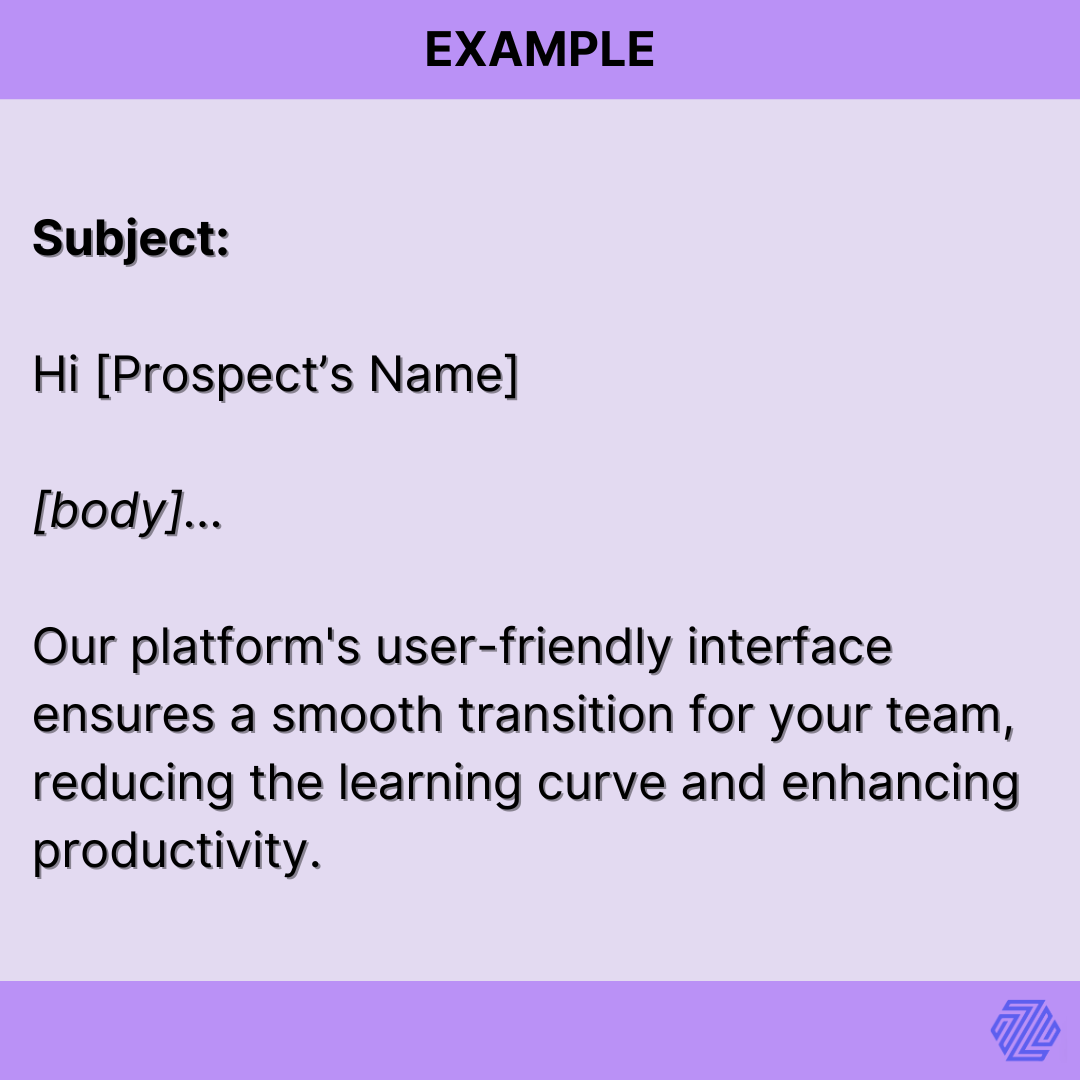
- Provide Proof: If you have success stories, testimonials, or case studies, incorporate them into your follow-ups to provide social proof.
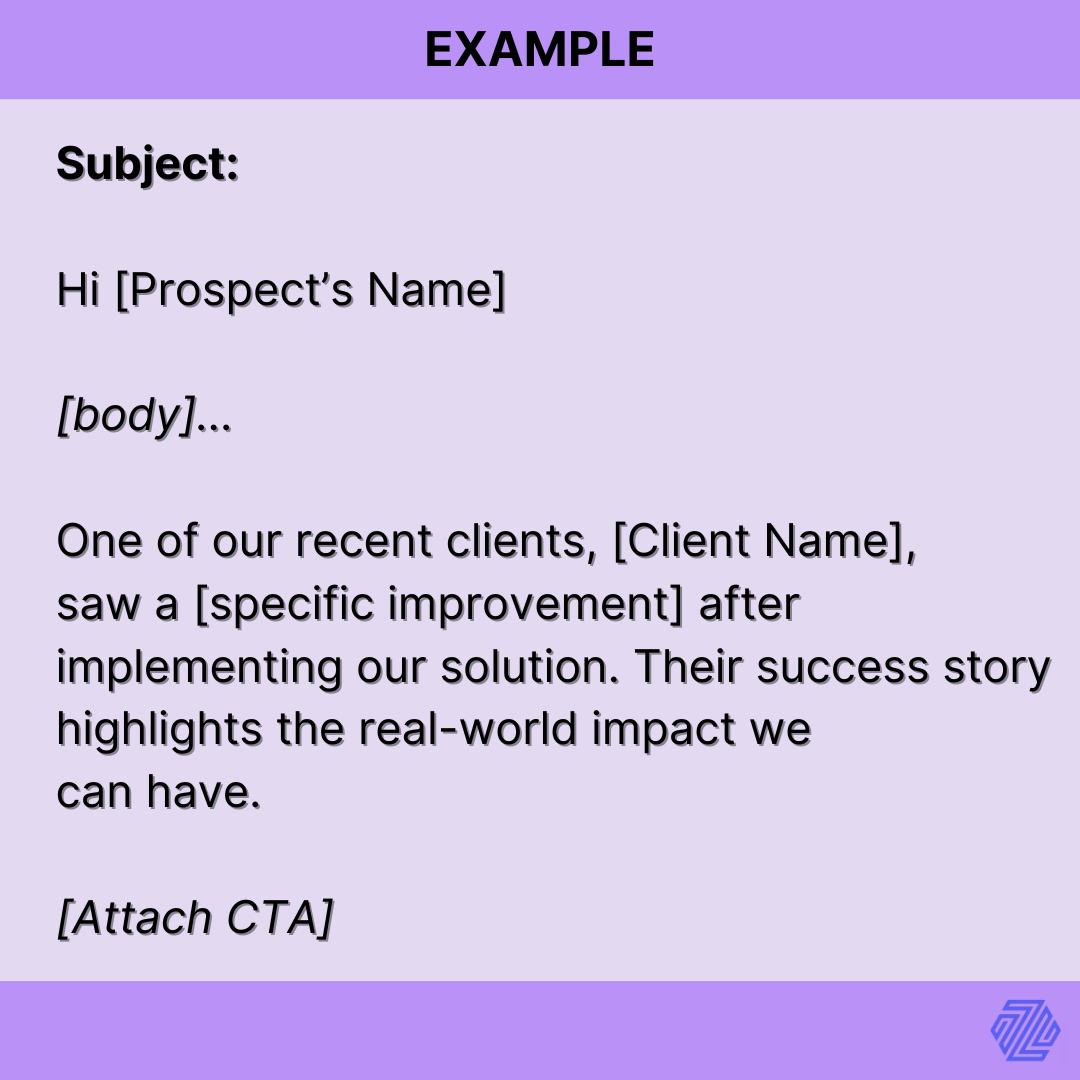
3.3. Using Persistence, Not Pestering:
When it comes to follow-ups, it’s essential to walk a fine line between being persistent and respectful. Here’s an in-depth look at knowing when to back off and handling unresponsive prospects:
Knowing When to Back Off:
- Set Clear Follow-up Limits:
Establish a predetermined follow-up sequence and stick to it. Determine how many follow-up emails you’ll send before considering the prospect unresponsive.
Example:
“We typically send a series of three follow-up emails. If we don’t receive a response after the third email, we consider it a pause point.”
- Evaluate Engagement Signals:
Pay close attention to any engagement signals from the prospect. If they open your email multiple times or click on links, it’s a positive sign.
Example:
“I noticed you’ve opened our last two emails. Does this mean you have questions or would like to discuss further?”
- Consider Their Busy Schedule:
Recognize that your prospect may have a hectic schedule. Avoid bombarding them with follow-ups during peak work hours.
Example:
“I understand you’re busy, and I appreciate your time. If you’re interested but couldn’t find a moment, please let me know when it’s convenient for you.”
- Respect Explicit Opt-Outs:
If a prospect explicitly requests not to receive further emails, immediately honor their request and remove them from your contact list.
Example: “I apologize for any inconvenience caused. I’ve removed your email from our outreach list as per your request.”
Handling Unresponsive Prospects:
- Change the Approach:
If your initial approach hasn’t yielded results, consider changing your messaging or offering. Address any objections or concerns the prospect might have raised.
Example:
“I’ve noticed you haven’t responded to our previous emails. Is there something specific you’d like to know, or a different angle we can explore?”
- Try Different Channels:
If email doesn’t seem to be effective, explore alternative communication channels like LinkedIn messages, Twitter, or even a personalized video message.
Example:
“I understand email might not be the most convenient way to connect. How about we continue this conversation on LinkedIn?”
- Extend the Follow-up Timeline:
Give unresponsive prospects more time before reaching out again. They might be facing internal delays or have other priorities.
Example:
“I realize things can get hectic. We’re here when you’re ready. Feel free to reach out whenever you’re comfortable.”
- Send a Polite “Break-up” Email:
As a last resort, consider sending a “break-up” email, politely expressing that you’re closing the communication loop but remaining open to future engagement.
Example:
“I haven’t heard from you in a while, so I assume this might not be the right time. I’ll respect your space but keep the door open if circumstances change.”
By understanding when to back off and how to handle unresponsive prospects with professionalism and respect, you can maintain a positive reputation while leaving the door open for potential future interactions. Remember that persistence should always be balanced with empathy and consideration for the recipient’s circumstances.
- Highlighting Previous Value Proposition:
Reinforce the key benefits of your product or service in the farewell email to leave a lasting impression.
Example: “I hope you’ll remember how [Your Solution] can significantly impact [Prospect’s Company] by [Key Benefit].”
Here are two example templates for “Break-up” emails.
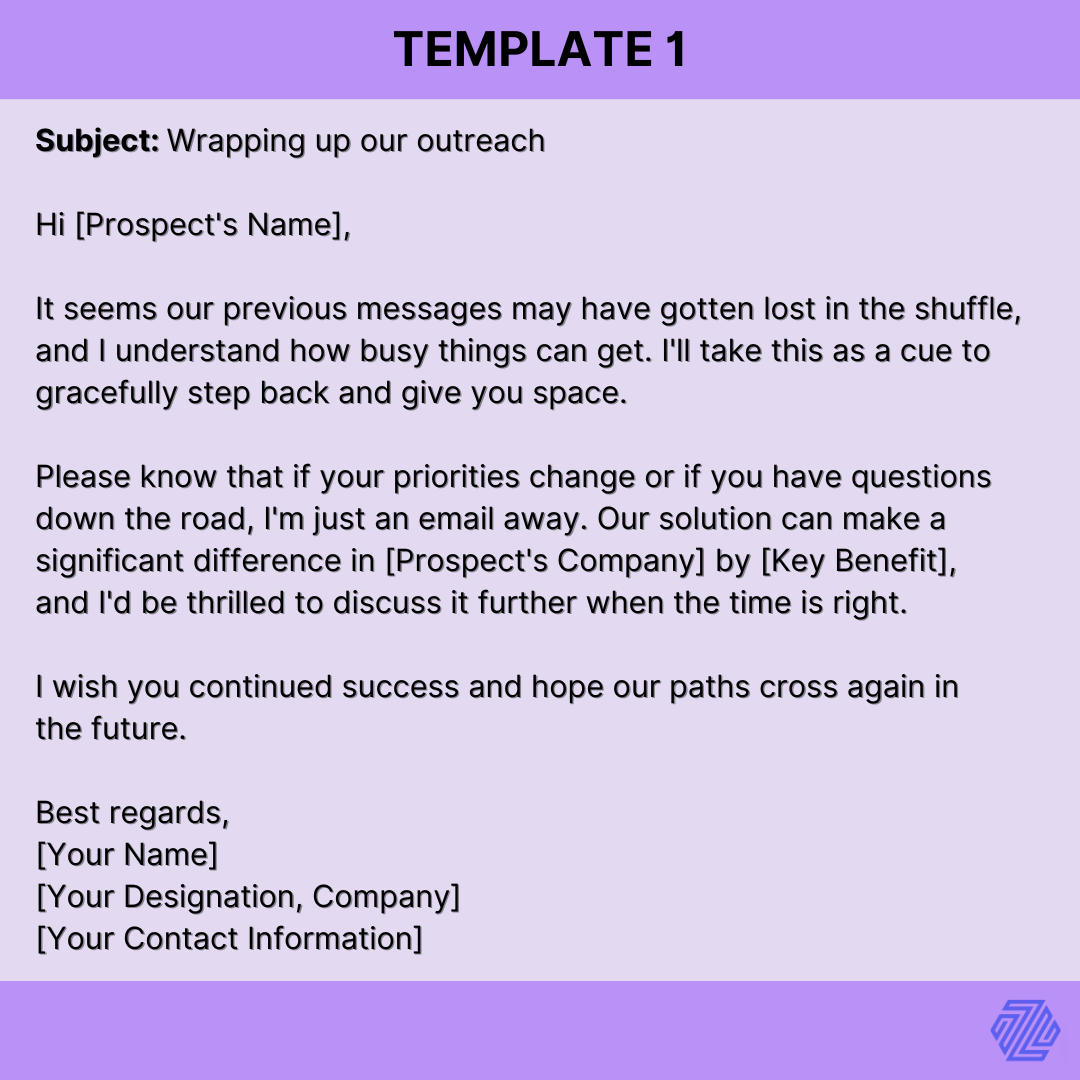 Break-Up email example template 1
Break-Up email example template 1
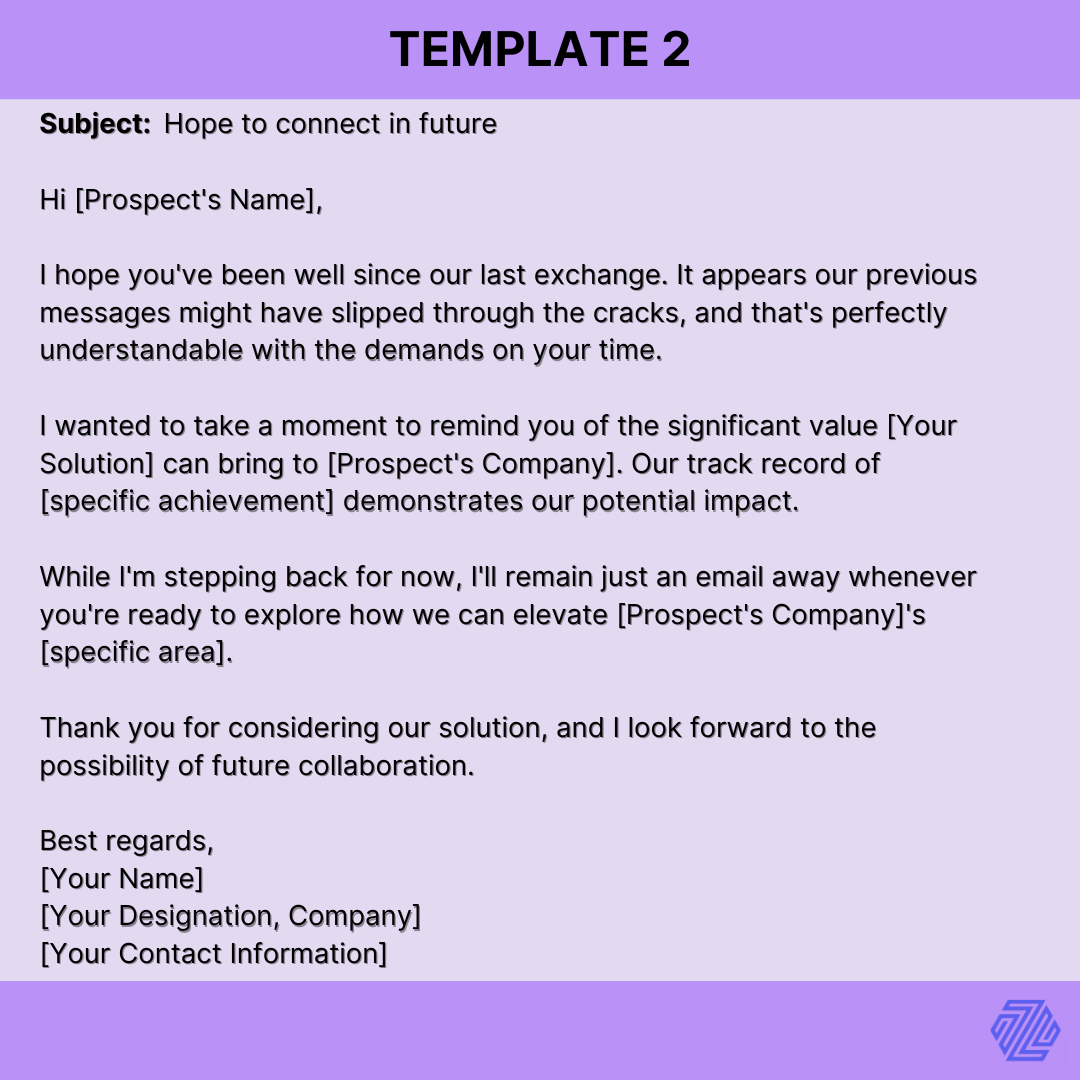 Break-Up email example template 2
Break-Up email example template 2
Bonus Section:
Some important tips and strategies that are often neglected but are very important to consider and implement, not only while creating the first email, but more so in follow-ups.
Section 4: Adding a Personal Touch
4.1. Personalization at Scale:
Personalization is a powerful tool in cold email outreach, but it can be challenging to implement at scale. Here’s a detailed look at how to achieve personalization efficiently:
- Dynamic Fields and Mail Merge:
Dynamic fields allow you to insert personalized information, such as the recipient’s name, company, or relevant details, into your emails automatically.

- Mail Merge Tools:
Use email marketing platforms with mail merge capabilities (e.g., MailChimp, HubSpot) to automate the insertion of dynamic fields.
With the help of an email marketing platform, you can seamlessly merge recipient-specific details into every email, making personalization at scale a breeze.
- Tailoring Messages to Pain Points:
Segment your email list based on common pain points or challenges your prospects face. Craft specific messages that address these issues.
Example:
“For prospects in the healthcare industry: emphasize how your software streamlines patient data management, a common pain point in the field.”
- Customized Value Propositions:
Adjust your value proposition to align with the recipient’s industry or role. Highlight the benefits most relevant to them.

4.2. Incorporating Social Media:
Social media is a valuable tool for enhancing personalization and engagement. Here’s how to incorporate it effectively:
- LinkedIn and Twitter Connections:
Connect with your prospects on professional networks like LinkedIn and Twitter to build familiarity before sending cold emails.
Example:
“I recently connected with you on LinkedIn and noticed your interest in [relevant topic]. I thought I’d reach out and share how we can add value to your [specific area].”
- Commenting and Engaging:
Engage with your prospects’ posts and content to establish a genuine connection and demonstrate your interest in their work.
Example:
“I saw your recent post about [topic], and I couldn’t agree more with your insights. It aligns perfectly with our approach to [related area].”
- Personalized Social Media Messaging:
Use direct messages on LinkedIn or Twitter to send personalized messages related to the recipient’s interests or shared connections.
Example:
“I noticed you follow [mutual connection]. They spoke highly of your work, and I’d love to connect and learn more about your initiatives.”
- Leveraging Common Interests:
If you share common interests or activities with your prospect, use this as a conversation starter.
Example:
“I see you’re a fan of [common interest]. I am too! It’s always great to connect with like-minded professionals.”
Incorporating personalization at scale and utilizing social media for engagement can make your cold outreach warmer and more effective. By showing a genuine interest in your prospects and tailoring your messages to their preferences, you increase the chances of establishing meaningful connections and ultimately achieving your outreach goals.
Conclusion:
The Art of the Follow-up is a Game Changer in Cold Emailing
In the ever-evolving world of business and communication, mastering the art of follow-up in cold emailing is a game-changer. It’s the key that unlocks doors, fosters connections, and transforms prospects into valuable leads. We’ve explored a comprehensive guide on how to excel in this critical aspect of outreach, combining strategy, etiquette, and adaptability.
Remember, cold email follow-ups aren’t just about persistence; they’re about professionalism, personalization, and respect. It’s a delicate dance of balancing the right timing, messaging, and strategy to leave a lasting, positive impression on your prospects.
The Road to Success banks on these two major factors:
Consistency and Adaptability
Consistency is your compass, and adaptability is your vehicle on the road to success in cold email follow-ups. Consistency ensures that your outreach remains reliable and maintains a professional presence in your recipients’ inboxes. It’s the rhythm of your follow-up sequence and the reliability of your responses.
On the other hand, adaptability is your ability to read the signs, pivot when needed, and tailor your approach to the unique needs and preferences of each prospect. It’s about embracing new techniques, staying compliant with evolving regulations, and continually refining your strategy based on data and feedback.
In the dynamic world of cold email outreach, the balance between consistency and adaptability is your secret weapon. Remember, it’s not just about sending emails; it’s about building relationships and nurturing them through every step of the journey.
Happy cold emailing!

